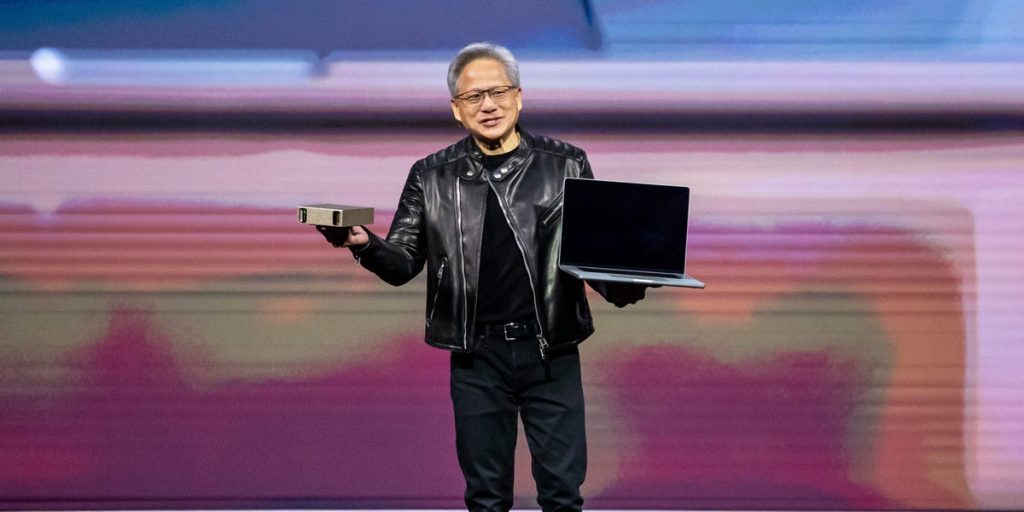Nvidia products are at the heart of the boom in artificial intelligence.
Despite starting in gaming and designing semiconductors that touch many diverse industries, the products Nvidia designs to go inside high-powered data centers are the most important to the company today, and to the future of AI.
Graphics processing units, designed to be clustered together in dozens of racks inside massive temperature-controlled warehouses, made Nvidia a household name. They also got Nvidia into the Dow Jones Industrial Average, and put it in the position to control the flow of a crucial but finite resource: artificial intelligence.
Nvidia’s first generation of chips for the data center launched in 2017. That first generation was called Volta. Along with the Volta chips, Nvidia designed DGX (which stands for Deep GPU Xceleration) systems — the full stack of technologies and equipment necessary to bring GPUs online in a data center and make them work to the best of their ability. DGX was the first of its kind. As AI has become more mainstream, other companies such as Dell and and Supermicro have put forth designs for running GPUs at scale in a data center too.
Ampere, Hopper, Blackwell, and Beyond
The next GPU generation designed for the data center, Ampere, which launched in 2020, can still be found in data centers today.
Though Ampere generation GPUs are slowly fading into the background in favor of more powerful models, this generation did support the first iteration of Nvidia’s Omniverse, a simulation platform that the company purports as key to a future where robots work alongside humans doing physical tasks.
The Hopper generation of GPUs is the one that has enabled much of the latest innovation in large language models and broader AI.
Nvidia’s Hopper generation of chips, which include the H100 and the H200, debuted in 2022 and remain in high demand. The H200 model in particular has added capacity that has proven increasingly important as AI models grow in size, complexity, and capability.
The most powerful chip architecture Nvidia has launched to date is Blackwell. Jensen Huang announced the step change in accelerated computing in 2024 at GTC, Nvidia’s developers conference, and though the rollout has been rocky, racks of Blackwells are now available from cloud providers.
Andrej Sokolow/picture alliance via Getty Images
Inside the data center, Nvidia does have competitors, even though it has the vast majority of the market for AI computing. Those competitors include AMD, Intel, Huawei, custom AI chips, and a cavalcade of startups.
Related stories
The company has already teased that the next generation will be called “Blackwell Ultra,” followed by “Rubin” in 2026. Nvidia also plans to launch a new CPU, or traditional computer chip alongside Rubin, which it hasn’t done since 2022. CPUs work alongside GPUs to triage tasks and direct the firepower that is parallel computing.
Nvidia is a software company, too
None of this high-powered computing is possible without software and Nvidia recognized this need sooner than any other company.
Development for Nvidia’s tentpole software stack, CUDA or Compute Unified Device Architecture, began as early as 2006. CUDA is software that allows developers to use widely known coding languages to program GPUs, since these chips require layers of code to work relatively few developers have the needed skills to program the chips directly.
Still “CUDA developer” is a skillset and there are millions who claim this ability, according to Nvidia.
When GPUs started going into data centers, CUDA was ready and that’s why it’s often touted as the basis for Nvidia’s competitive moat.
Within CUDA are dozens of libraries that help developers use GPUs in specific fields such as medical imaging, data science, or weather analytics.
Nvidia began at home
Just two years after Nvidia’s founding, the company released its first graphics card in 1995. For more than a decade, the chips mostly resided in homes and offices — used by gamers and graphics professionals.
The current generation includes the GeForce RTX 5090 and 5080, which was released in May 2025. RTX 4090, 4080, 4070, and 4060, were released in 2022 and 2023. GPUs in gaming enabled the more sophisticated shadows, texture, and light to make games hyperrealistic.
In addition to the consumer work stations, Nvidia partners with device-makers like Apple and ASUS to produce laptops and personal computers. Though gaming is now a minority of the company’s revenue, the business continues to grow.
Nvidia has also made new efforts to enable high powered computing at home for the machine-learning obsessed. It launched Project DIGITS, which is a personal-sized supercomputer capable of working with some of the largest large language models.
Nvidia in the car
Nvidia is angling to be a primary player in a future where self-driving cars are the norm, but the company has also been in the automotive semiconductor game for many years.
Kim Kulish/Corbis via Getty Images
It launched Nvidia DRIVE, a platform for autonomous vehicle development, in 2015, and over time it developed or acquired technologies for mapping, driver assist, and driver monitoring.
The company designs various chips for all of functions in partnerships with Mediatek and Foxconn. Nvidia’s automotive customers include Toyota, Uber, and Hyundai.


